Bringing the Next Generation Mineral Nutrition Solutions
- Innovation
By Dr. Mahesh GR, Technical Team, Trouw Nutrition India
Introduction:
Trace minerals (TM) play a crucial role in various metabolic and biological processes within the animal’s body. For example, Zn is a component of metalloenzymes, whereas Cu and Mn are cofactors for many enzymes. Given their importance in physiological processes, they play a vital role in the growth, production, and reproduction of animals. Numerous research have been conducted with respect to the TM requirements of animals according to their age, production stage, stress conditions, etc. The common practice of feeding extra does not apply to trace mineral nutrition as higher levels do not guarantee improved performance. The common sources of TM used even today are mostly inorganic (sulfates or oxides) which have different bio availabilities based on the method of mineral production (source or base materials used for production).
Sources of trace minerals
Inorganic:
Inorganic trace minerals (ITM) are a group of minerals that are bound to groups like sulfates (SO4), chlorides (Cl), or oxides (O) through ionic bonds (Taylor and Field, 1995). ITM are most widely used globally for decades due to its low cost. ITM has many limitations such as low bioavailability, higher reactivity, lesser stability, and higher interactions with other nutrients, in feed as well as in the gut of animals. Mwangi et al. (2017) reported ITM sources irritate the intestinal mucosa, form a complex with other nutrients, and finally get expelled into the environment. Sulfate trace minerals contain a metal ion bound to a sulfate ion via an ionic bond. This ionic bond breaks apart easily in an aqueous environment, releasing a free metal ion at liberty to interact with other nutrients. Organic and IntelliBond (Trouw nutrition) hydroxy trace minerals (fig 1) contain stronger covalent bonds that protect the metal from being released too early in the feed or digestive tract, giving them an advantage in diet stability, palatability, digestibility, and bioavailability over sulfate trace minerals.
Fig 1. Chemical structures of different trace mineral sources

Chelated Organic Forms:
OTMs are formed by the chelation of inorganic minerals with organic ligands like amino acids, proteinates, or carbohydrate moieties. In chelation, the metal ion was bound strongly with organic molecules (ligands) through a covalent bond (Fig-2) to form a ring structure. Optimal chelation provides the highest stability to the chelate with the right amount of trace mineral being made available at the point of absorption, enhancing the bioavailability of trace minerals fed. However, given the varied production processes, the variability in ligand selection, and lower mineral concentration, there is a lot of concerns around the selection of the right chelated forms.
Fig 2. Chelated Trace Mineral structure:
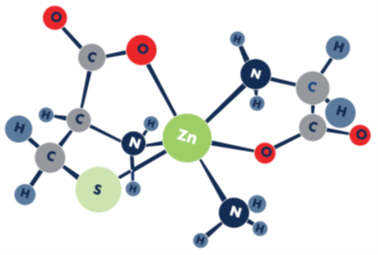
Hydroxy Forms:
HTM is the new group of minerals that offers optimal delivery of highly bioavailable trace minerals at the right part of the gastrointestinal tract. HTM is produced by reacting a pure form of mineral with an alkali to form a hydrolyzed inorganic metal complex. HTM is non-hygroscopic, free of dust, and non-oxidative due to the presence of covalent bonds in its crystalline structure (Leisure et al., 2014), and exhibits superior bond strength (Fig 3). HTM are considered inorganic as they are covalently bound to an OH group instead of carbon-containing ligands like organic TM (Arthington, 2015). European Union approved the usage of HTM in all animal species and even in organic feeds.
Fig 3. Hydroxy trace minerals with overlapping crystalline structure:
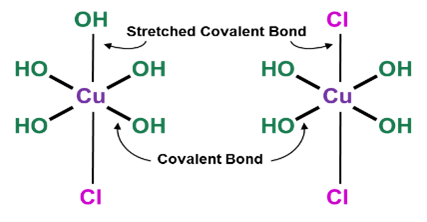
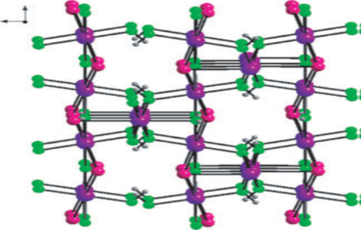
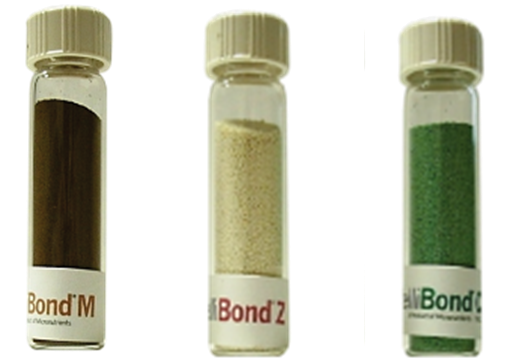
Above crystalline structure allows slow and steady release of trace minerals with significantly higher bioavailability than their counterparts (fig 4) which supports better animal performance and wellbeing.
Fig 4. Bioavailability of inorganic, chelated and hydroxy zinc forms:
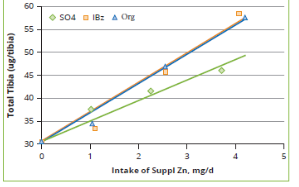
As opposed to chelated mineral forms, the hydroxy ones, have higher metal content and are comparatively priced much lower.
Impact of hydroxy trace mineral sources:
The rapid growth of modern birds will increase the susceptibility of birds to oxidative stress and pathogens which in turn leads to reduced performance. Poultry diets supplemented with organic or hydroxy trace minerals showed better performances and immune responses compared to inorganic trace minerals due to the better bioavailability of minerals. M ´Sadeq et al. (2018) reported broilers fed with optimum levels of hydroxy minerals showed greater feed efficiency, increased percentage breast yield, and greater weight gain than sulfate source. Similarly, Olayinka et al. (2019) observed superior weight gain in broiler chickens supplemented with HTM as compared to those receiving sulfate trace minerals at 15, 80, and 80 ppm of Cu, Zn, and Mn. Broiler groups fed with lower levels of OTM and HTM showed higher weight gain and lower FCR at a lesser cost as compared to ITM fed group showing the superiority of HTM and OTM over inorganic sulfates or oxides (Perez et al., 2017). Egg loss due to defective eggshells was reduced by using hydroxy Zn, Mn, and Cu trace minerals in place of sulphate inorganic sources. Toghyani et al. (2019) concluded that using hydroxy sources of Cu, Zn, and Mn in layer diets will improve feed stability, egg production rate, and FCR. Toghyani and coworkers conducted an experiment to estimate the effect of replacing ITM with HTM sources on egg production, egg quality parameters, and feed stability in layer diet during post-peak production. The inclusion of hydroxy Zn, Cu, and Mn reduces the extent of oxidation in the feed, as indicated by lower peroxide, higher free fatty acids, and higher iodine values in feed samples.
In addition, Enzymes added to the diet are also susceptible to degradation by free inorganic metals. Phytase fed to improve phosphorus availability in poultry diets showed 16% greater retention in the feed when formulated with IntelliBond copper compared to copper sulfate, indicating prevention of phytase degradation during feed storage (Liu et al., 2005). Using a less reactive HTM and OTM source appears to protect vitamins, lipids, and enzymes in feed, ensuring the nutrients formulated to retain their optimum quantity and quality.
Copper, zinc, and manganese help in reducing oxidative stress and enhances immunity by acting as a cofactor for the enzyme Superoxide dismutase (SOD). Perez et al. (2017) showed an increased level of superoxide dismutase (SOD) when feeding increasing levels of Zn and Mn in both laying hens and broiler chickens challenged with lipopolysaccharides. In laying hens, a similar SOD level was reached with lower levels of Zn (50 ppm) and Mn (45 ppm) from HTM compared to higher levels (100 ppm Zn and 90 ppm Mn). Olayinka et al. (2019) reported that plasma levels of methylmalonic and uric acid are low in broiler chickens supplemented with a hydroxy form of Zn and Cu. Hence, talking of trace mineral forms that assure their availability and further utilization in animal bodies, two forms that clearly stand out of the various other sources are the chelated and hydroxy forms. Lower concentrations of hydroxy and organic forms of minerals in poultry diets have been recommended as a solution to reduce the excretion of minerals without any objectionable effect on performance.
Combining the best of both worlds – the hydroxy and chelated forms in this case has been observed to yield better results than when provided individually to animals. An innovative offering from Trouw Nutrition, that is in line with this concept is “IntelliOpt” – a precision trace mineral technology, that has been designed and validated through various animal trials. IntelliOpt combines the hydroxy (Selko Intellibond) and chelated (Optimin) forms at optimal levels in one convenient package to consistently deliver higher mineral bioavailability.
Conclusion:
The main goal of trace mineral nutrition is to meet the ever-increasing nutritional demands of today’s high-producing animals without any harmful interaction with other nutrients in the feed in a sustainable manner. OTM and HTM are the most viable options available in achieving the goal of better bioavailability of TM to animals, while OTM is costlier than HTM. To obtain the higher bioavailability of trace minerals at a cost-effective price, both organic and hydroxy sources of trace minerals could be combined (IntelliOpt). Practicing this precision trace mineral nutrition is essential for optimizing the production cost, decreasing environmental pollution, improving animal productivity and better well-being.
For further information, kindly write to us at customercareindia@trouwnutrition.com